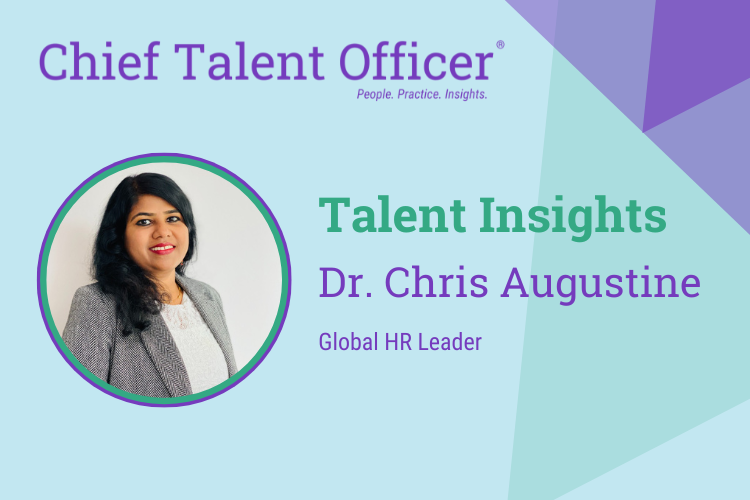Chief Talent Officer’s “Talent Insights” series is dedicated to sharing the insights and expertise of influential talent executives. In this Q&A series, we garner strategic insights, innovative approaches and challenges overcome from C-suite talent and HR executives, chief talent officers, chief people officers and others who are shaping the future of talent management.
What initially drew you to a career in talent management, and how have your experiences in the field evolved over the years?
I love human behavior, which led me to deeply specialize in organization behavior through my exceptional doctoral work in applied psychology. My USP is the intersection of human resources with a psychology edge, which ensures talent solutions for tangible business outcomes.
Through my 15-plus years in HR leadership across diverse sectors and industries, my unique vantage is that I address the source or the root of business and people issues, ensuring culture transformation rather than delivering a symptomatic, shallow, temporal approach and outcomes.
What core values and principles do you believe are essential for building a positive and inclusive company culture?
Empathetic leadership with integrity (authenticity) will promote inclusiveness and equity in the workplace. These two core values are indispensable to an organization’s DNA, and research shows that AI lacks these values systemically. Hence, humans imbibe and nurture intentionally for tangible inclusion and culture outcomes in this AI age.
Can you share a significant challenge you’ve faced as a talent leader and how you successfully navigated through it?
In technology organizations, there are not many women in leadership roles across certain ethnic and racial cultures, geographies and communities. Most of them are positioned in junior roles, and most drop out through their career trajectory due to personal life changes. As a data-centric HR, I did a deep dive into this aberration and strategically carved out a powerful strategy on “growing women leadership,” especially in complex tech functional skills and other administrative roles. When I deployed this robust strategy at Ness Digital Engineering, I grew the women in leadership by 20 percent in 12 months, ensuring the CXO team as huge sponsors of this initiative.
What strategies have you found most effective in attracting and retaining top talent in competitive industries?
I have found two powerful talent strategies that are absolutely compelling in attracting and retaining top talent. I have deployed these two talent strategies at three different organizations and have observed tangible outcomes.
One is a wellbeing strategy encompassing family wellbeing, financial wellbeing, physical wellbeing, mental wellbeing, career wellbeing and social well being, ensuring 360-degree coverage.
Second, I am an ardent influencer on the DEIB strategy, ensuring the top talent hiring, advancing, promotion and learning. The entire talent management function was reimagined on the principles of this DEIB strategy.
How do you balance advocating for employees’ needs while aligning with your company’s business objectives?
I am a firm believer in employee advocacy aligning with the organization’s strategic priorities, objectives and key results. I ensure this balance by embedding employee-friendly policies, alleviating deep and basic needs proactively with data, even before employees reach out. I have built and embedded a talent model where employees become the business brand rather than HR driving this balance and, ultimately, tension between employees and management.
“It is a highly volatile, uncertain, complex and ambiguous AI age; talent professionals need to be futuristic, agile and skill-ready.”
What leadership skills do you prioritize and cultivate as a senior talent leader to inspire your team and drive talent initiatives?
Empathetic leadership with Thought leadership are my style to influence, inspire, impact, impress and ignite my team members in high-priority talent initiatives. I have observed this has elevated the inclusion, equity, accessibility and belonging of each and every member.
What game-changing advice would you offer if you could go back in time and mentor your younger self?
Keep taking risks (across industry, sector, role, process, technology, ambitions) quickly; do not linger. Just more and more experiments, slipping is normal — jump back quickly with 3x horsepower!
What do you feel is currently the single biggest challenge facing talent professionals and the industry as a whole?
It is a highly volatile, uncertain, complex and ambiguous AI age; hence, talent professionals need to be futuristic, agile and skill-ready, perhaps to judiciously navigate external factors such as conflict, cost pressures, COVID uncertainties, climate change and internal triggers on culture transformation to thrive and excel for robust employee value proposition.
We’re always looking to showcase innovative tools and technologies. Can you share one tech product or platform that has significantly improved your work processes and why you find it valuable?
15Five’s AI-driven employee engagement platform is simply a transformational tool in building inclusion. I built a Belong Dialogue toolkit around it, which arrested turnover by 12 percent, and belonging climbed by 4 out of 5. Above all, we need to integrate and streamline all existing disparate enterprise tools for a holistic talent lens.
Interested in being featured in our “Talent Insights” series? Please complete this FORM.












